I am a sculptor who has always looked to Rembrandt as the great master of drawing, his expression of human relationships was superior to the older masters because he insisted that he was taught by nature. He recreated the relationships with groups of models, or actors and then drew them. The experts have subconsciously tried to subvert him to modern tastes as an inventor. I will be showing you the observer.
The drawings show us the true Rembrandt more vividly than the paintings.
Please do not say to yourselves,” I know nothing about art” because in 20 minutes you will know more about the real Rembrandt, and therefore about art and artists, than those who have been studying him for a life-time. Its very simple.
Over the last forty years the number of works accepted as by Rembrandt has been cut by half. I need to persuade you of 4 things to show you that this is a huge mistake. The scholars are looking for the wrong kind of artist
AIMS
1. To show that Rembrandt was a very variable artist
2. To show he was an observer, not the inventor the scholars look for. (All his inventions are outstandingly crude/clumsy as we will see soon)
3. To show that he used live models/actors as an important aspect of his art. (He shows us how the human spirit expresses itself in the physical world.)
THEREFORE, REMBRANDT SCHOLARSHIP NEEDS TO START ALL OVER AGAIN
The damage started nearly 100 years ago. Here is a drawing that was dismissed by the experts in 1922.
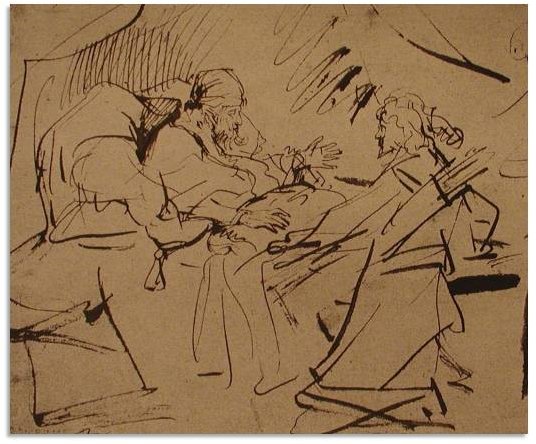
Isaac refusing to bless Esau
We can all see the great difference between Isaac and Esau. The experts must have looked at that Esau and said to themselves – Rembrandt could never have drawn that! And dismiss it. They see the awkwardness but evidently do not see the greatness of Isaac. Here is an old Jew on his deathbed refusing to bless his eldest son Esau. Old Isaac has been cheated and has given his blessing to the younger brother, Jacob. His gesture is superb – you feel the blindness, the fatalism and the extreme old age. This Isaac is Rembrandt at his very best.
Esau on the other hand is certainly expressive of shock but there is no physical substance to his body, it is cardboard. Only his head is the same caliber as Isaac. There is another drawing of Esau on the other side of the bed.
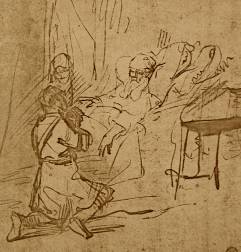
Esau on the other side of the bed
My explanation of the obvious difference in quality between these 2 figures is that Isaac is drawn from life and Rembrandt could only see Esau’s head – the body is hidden behind the bed – it is made up.
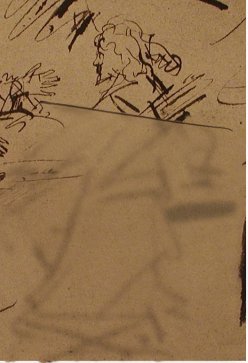
If you look carefully at his head

you will see that it has been enlarged by this line to bring it to this side of the bed – – but you can still see the smaller head Rembrandt drew first.

Here you see the two sides of Rembrandt – the brilliant observer, in Isaac and the far from brilliant inventor in Esau. If I had time I could show you this huge difference in quality between observed and invented many times. This is the basic Rembrandt characteristic that the experts fail to acknowledge.
This drawing defines the real Rembrandt perfectly but no scholar has considered it since 1922. We see the same division in the paintings. Obvious examples – the horses in The Polish Rider, or the Fredrick Rihel portrait.(Strasbourg Rider)
My version of Rembrandt is in complete agreement with what Rembrandt’s contemporaries tell us about him.
Quotes – coming soon
Modern scholarship has made up its own theories of Rembrandt’s development, without reference to the long established facts of Rembrandt’s artistic character. My discoveries have confirmed those facts. The experts want Rembrandt to be consistent – he was not – I will be showing drawings from mirror images, which have caused a more subtle decline in the quality in his work.
Unfortunately modern scholarship, over the last 100 years, has been wandering further and further from the original Rembrandt. Sadly there is no compromise position – either the experts are right and I am mistaken about him drawing from models, or, his contemporaries and I are right and recent experts are so gravely mistaken that they are no longer experts – they have swallowed the idea from their professors – that he drew from “an inner vision” and that idea has been completely invalidated. But present scholarship refuses to take note. Rembrandt is a weather-vane of feeling – not the consistent producer they wish to establish.
This could be great news for the rest of us because I see a very much larger, richer and more human Rembrandt.
Mr. Schatborn, recently of the Rijksmuseum, thinks there are only 500 drawings by Rembrandt extant today, Benesch in 1954 thought there were over 1400, I think there are over 2000.
I see Rembrandt the observer, where modern scholarship has reshaped him to conform with modern ideas about creativity; closer to the inventor, Picasso, than to the great observer known to Rembrandt’s contemporaries. We humans have a dangerous propensity to convert heroes to conform to our own contemporary tastes.
There are four good reasons why we need to take a much more generous, broad-view of Rembrandt’s production. I have shown you his variability.

He was at his best when he drew direct from nature. This is a page from my 1978 article in RembHuis kroniek.
I made this BBC film in 1976

David appointing Solomon as his successor. I regard this as top quality Rembrandt
When drawing from a reflection we must expect a lesser quality due to the poor quality of a reflection in polished metal.
Isaac and Jacob
When he drew from what we wrongly call “imagination” that is, out of his head, we must expect a bigger drop in quality. This may come as a surprise to many because of our long-standing mis-education in this respect. There are many artists similar to Rembrandt who work exclusively from observation, and maybe despise constructed drawing because it is spatially crude.
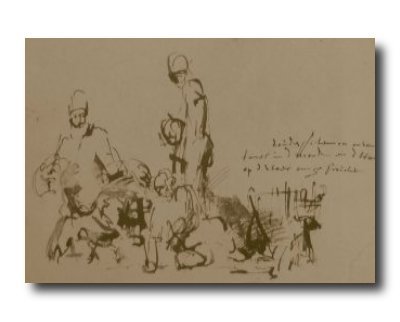
Jupiter and Baucis
We can be sure that this drawing is by Rembrandt, it has his writing on it and the writing tells the story that the drawing itself fails to tell. This is a sample of Rembrandt drawing without physical reference.
The etchings (mainly signed and dated on the plate) also show Rembrandt to be a very varied artist.
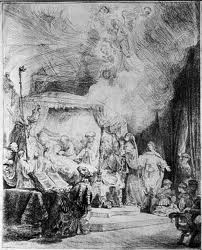
Death of the Virgin - Etching by Rembrandt
In the interest of true understanding we must not allow this natural variability to be tidied away. Rembrandt himself did not destroy his weaker works. His acceptance of failure as a normal outcome of experiment is an important aspect of his creativity. He was deeply concerned with the truth – he has shown us his weaknesses as well as his strengths: he was utterly truthful about himself and what he saw. He is therefore the most transparent artist I know. He was selling us his vision, not his craftsmanship, which could sometimes be surprisingly slipshod. (i.e. Bathsheba’s head below from the appointment of Solomon drawing above.)
***************
Rembrandt was an observer, who set up elaborate groups in his studio for himself and for his students to work from The Evidence for this is abundant. I expect to persuade this open-minded audience that there were models and a large mirror in Rembrandt’s studio in two minutes.

The great importance of the mirrors is that they prove the presence of the live models to be reflected. Here we see a group of four – acting as musicians, in fact, neither of the two real models knows how to hold their instruments (the oboist’s hands are too close to the mouthpiece, and the flautist has his instrument entirely the wrong way round) luckily he is reversed in the mirror so his reflection plays the flute correctly, note also how accurately the angle of the oboe is reflected in the fourth musician. These feathers are invented and therefore “worthless in Rembrandt’s eyes”.
Naturally Rembrandt used a mirror for his self-portraits. This example shows us that Rembrandt used a much larger mirror probably made of polished pewter or copper. Glass mirrors would have been made of many small pieces joined together. This mirror is large enough to reflect two standing men. The mirror proves this to be a studio re-creation. We should note that Rembrandt would not have gone to the trouble of producing this group if he had a photographic memory.
His inventory tells us that Rembrandt owned a large theatrical wardrobe and many props for the purpose of creating these tableaux – obviously.
The Stoning of St. Stephen.(B.959)
This example is even more telling. One could be forgiven for thinking this drawing was constructed, not observed, it seems so schematic. But even for this drawing Rembrandt posed three models in front of a large mirror. There is a right-handed stone thrower and a left-hander. This man cowering is drawn twice in reflection, St Stephen gives rise to this man reaching for a stone. Most telling, Rembrandt has even drawn in the base of the mirror – because it was there.
This use of mirrors is something that Rembrandt did nearly 100 times in drawings. See Mirrors section of www.SaveRembrandt
and once with the two paintings of “The Adoration of the Shepherds”. See Adoration section in www.SaveRembrandt.org.uk
Also see Youtube video
These paintings are of defining importance because the very size of the reflected group, the elaborate costumes and accessories of the individuals in the group, proves beyond all reasonable doubt, that what I have been saying since 1974 is correct.
The very complex interrelationship between these two paintings could not have happened by any other means, than the mirror. The London version is a reversal of a different point of view of the same 3D array of persons and objects, seen in Munich. This could not happen by chance.
Therefore Rembrandt scholars are fundamentally mistaken. We must start all over again with entirely different criteria for Rembrandt. I believe I can teach fresh minds how to set about it. My book, as yet unpublished, would be their text book.
The film of “The Adoration” on Youtube you can play over and stop the action, to compare the paintings with the photographs of the maquettes. We must not expect a perfect match. The models were human, so was Rembrandt.
In the 20 minutes available it is impossible to say ¼ of what needs to be said but I hope I have persuaded you that it is a matter of urgency that Rembrandt scholarship is revised.
In my youth Rembrandt was the great sign-post for art students. Now students no longer trust him. They do not know whether they are looking at a Rembrandt or one of his students.
This mess is a tragedy for art, a tragedy for us all, not just for Rembrandt. I have been saying this now for 36 years without effect, I need your help to bring about change in Art History.
I would be happy to instruct the young on how to set about it. I need to do this in a school of art; not of art history; because practical drawing is absolutely necessary as a basis for understanding Rembrandt’s cast of mind. He was on a journey of discovery, he did not allow the perfection of a work to slow him down. This is why his art is so transparent and instructive.
The scholars think they have mastered his handwriting, they should focus instead on his subject matter; which really interested Rembrandt. Even with the handwriting they are gravely mistaken. You will see in my DVD just how hopelessly wrong they are in the dates they assign to his drawings, let alone the re-attributions. More of the same in my published articles, more still in my as yet unpublished book on Rembrandt and on my web site and blog.
web site www.saveRembrandt.org.uk
and blog www.verrocchio.co.uk
I have prepared a small booklet and over an hour’s worth of DVD which you can study at leisure.
****************
Here we are in a hive of creativity; Together can we develop a scheme for improving the situation in art history? A foundation – PINC for the Greater Rembrandt?